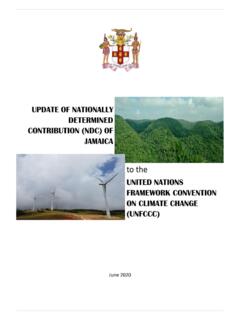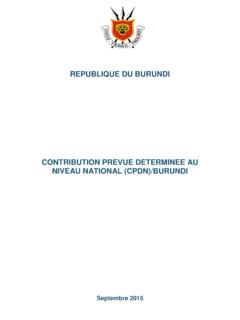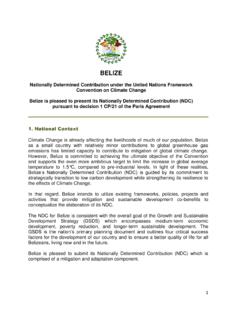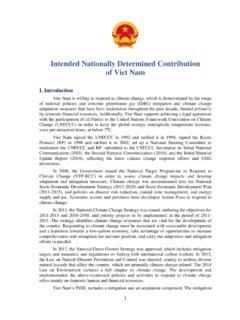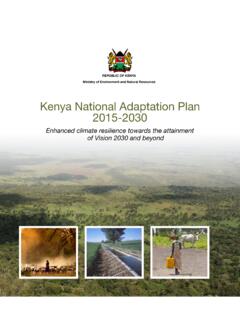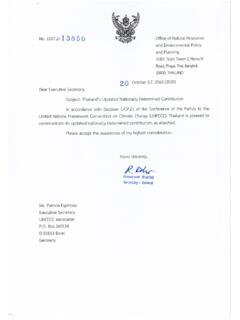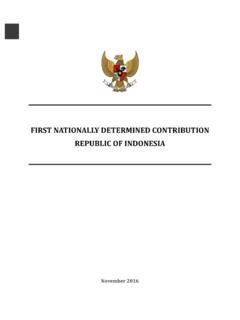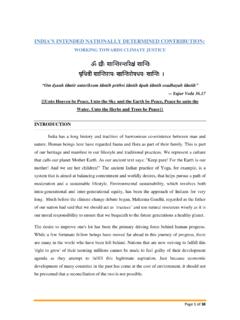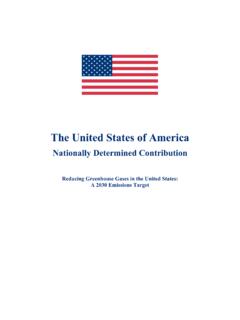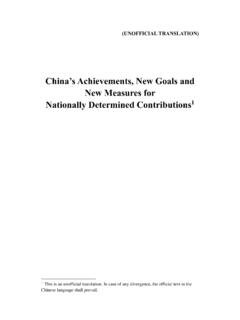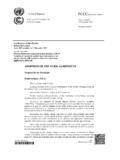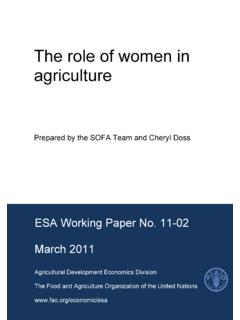Transcription of UPDATED NATIONALLY DETERMINED CONTRIBUTION (NDC)
1 THE SOCIALIST REPUBLIC OF VIET NAM UPDATED NATIONALLY DETERMINED CONTRIBUTION (NDC) Ha Noi, July 2020 i TABLE OF CONTENTS I. INTRODUCTION .. 1 Overview .. 1 Summary of UPDATED contents compared to current NDC .. 3 General issues .. 3 Mitigation .. 3 Adaptation .. 4 II. MITIGATION COMPONENT .. 4 Viet Nam's efforts and achievements in mitigation .. 4 Policy framework supporting implementation of GHG reduction targets .. 4 Efforts to reduce GHG emissions in different sectors .. 5 BAU 6 Mitigation contributions .. 7 Measures to achieve GHG reductions in different sectors .. 10 Energy .. 10 Agriculture .. 11 LULUCF .. 11 11 Industrial processes (IP).. 11 III. ADAPTATION COMPONENT .. 11 Climate change in Viet Nam .. 11 Climate change in Viet Nam through monitoring data.
2 11 Projections of climate change in Viet Nam toward 2100 .. 12 Increased climate-induced risks .. 12 Impacts of climate change on sectors and regions .. 13 Loss and damage .. 16 Viet Nam's efforts and achievements in climate change adaptation .. 17 Adaptation policies .. 17 Adaptation efforts .. 18 Adaptation contributions .. 20 Improving adaptation efficiency through strengthening state management and resources .. 20 Enhancing resilience and adaptive capacity of communities, economic sectors, and ecosystems .. 20 ii Reducing disaster risks and minimising damage, increasing preparedness to respond to increasing natural disasters and climate extremes due to climate 20 Gaps and needs for enhancing climate change adaptation .. 21 IV. SYNERGY AND CO-BENEFIT .. 21 Synergy between climate change response and socio-economic development.
3 22 Mitigation in relation to socio-economic development .. 22 Adaptation in relation to socio-economic development .. 22 Synergy between climate change response and sustainable development goals 22 Co-benefits between climate change adaptation and 22 V. IMPLEMENTATION OF UPDATED NDC .. 23 Impact, advantages and challenges in implementation of UPDATED NDC .. 23 Potential impact from implementation of UPDATED NDC .. 23 Advantages in implementation of UPDATED NDC .. 24 Challenges in implementing UPDATED NDC .. 25 Implementation of UPDATED NDC .. 29 Measures to promote implementation of UPDATED NDC .. 29 Implementation responsibilities .. 31 Arrangement of resources for implementation .. 32 Monitoring and Evaluation .. 34 Developing the enhanced transparency 34 Evaluation criteria.
4 37 Organisation of Monitoring and Evaluation .. 38 Process of Monitoring and Evaluation .. 38 VI. HIGHLIGHTS OF UPDATED NDC .. 39 Unified in directing and effective participation of stakeholders .. 39 Novelty and comprehensiveness .. 40 Fairness and best efforts .. 40 iii LIST OF TABLES Table 1. GHG Inventory in 2014 and BAU Scenario to 2030 .. 7 Table 2. Reduction contributions .. 8 Table 3. Reduction CONTRIBUTION by sectors .. 10 Table 4. Challenges in implementing UPDATED NDC and related measures .. 26 LIST OF FIGURES Figure 1. GHG emissions under the BAU Scenario .. 7 Figure 2. MRV system model for GHG reduction .. 35 Figure 3. Diagram for the MRV process of GHG reduction .. 35 Figure 4. M&E system for adaptation at the national, local and project levels .. 36 Figure 5. Process for developing the M&E system for adaptation at national level.
5 37 iv ABBREVIATIONS AF Adaptation Fund BAU Business as usual BTR Biennial Transparency Report BUR Biennial Update Report COP Conference of the Parties CPI Consumer price index FDI Foreign direct investment GCF Green Climate Fund GEF Global Environment Facility GHG Greenhouse gas INDC Intended NATIONALLY DETERMINED CONTRIBUTION IP Industrial Processes LULUCF Land use, land use change and forestry M&E Monitoring and Evaluation MRV Measurement, Reporting and Verification NAP National Adaptation Plan NAMA NATIONALLY appropriate mitigation action NC National Communication NCCC National Committee on Climate Change NDC NATIONALLY DETERMINED CONTRIBUTION ODA Official development assistance PIPA Plan for Implementation of the Paris Agreement REDD+ Reducing Emissions from Deforestation and forest Degradation, plus the sustainable management of forests, and the conservation and enhancement of forest carbon stocks RDF Refuse derived fuel (from plastic and paper waste) TOE Ton of oil equivalent UNFCCC United Nations Framework Convention on Climate Change 1 I.
6 INTRODUCTION Overview At the 21st Conference of the Parties (COP21) in 2015, the Parties to the United Nations Framework Convention on Climate Change (UNFCCC) adopted the Paris Agreement. This is a historic agreement, the first global legal framework binding the responsibilities of all Parties in joint efforts to combat climate change. The implementation of each Party's responsibilities for climate change response is primarily reflected through the Intended NATIONALLY DETERMINED CONTRIBUTION (INDC). Viet Nam's INDC comprises two components, namely mitigation and adaptation. The mitigation component identifies the roadmap for GHG reduction in the period 2021-2030 for the following sectors: energy; agriculture; land use, land-use change and forestry (LULUCF); and waste.
7 The business-as-usual (BAU) scenario was developed using 2010 as the base year, and provides projection for 2030. With domestic resources, by 2030 Viet Nam will have reduced GHG emissions by 8% compared to the BAU scenario. This CONTRIBUTION can increase by up to 25% with international support through bilateral and multilateral cooperation and the implementation of new mechanisms in the Paris Agreement. The adaptation component identifies the efforts that have been implemented; the institutional, policy, financial, human resource and technology gaps; and the prioritised adaptation actions for the period 2021-2030. Viet Nam submitted the INDC to the UNFCCC Secretariat in September 2015; signed and approved the Paris Agreement in April and October 2016, respectively; and issued the Plan for Implementation of the Paris Agreement (PIPA) in October 2016.
8 After the Paris Agreement entered into force, the Parties INDCs became NATIONALLY DETERMINED Contributions (NDCs). Since the submission of its NDC, Viet Nam has developed and issued several important policies on climate change response at the national level, such as the Resolution of the Politburo of the Central Committee of the Communist Party of Viet Nam on the orientation of Viet Nam s National Energy Development Strategy to 2030, with a vision to 2045 (2020); Viet Nam s Renewable Energy Development Strategy to 2030, with a vision to 2050 (2015); the Revised National Power Development Plan (PDP) for 2011-2020 with a vision to 2030 (revised PDP VII) (2016); the PIPA (2016); the National Action Plan for Implementation of the 2030 Agenda for Sustainable Development (2017); the Target Programme for Climate Change Response and Green Growth for the period 2016-2020 (2017).
9 Among the above-mentioned documents, the PIPA materialises Viet Nam s international commitments on climate change response, including 68 groups of tasks to be implemented by 2030 on climate change mitigation and adaptation, resource mobilisation, enhancing and improving institutional frameworks, and establishing the enhanced transparency frameworks on responses and support received for responses to climate change. The content of Viet Nam s NDC has been comprehensively reflected in its corresponding Plan, which identifies the tasks requiring the most ambitious and continuous efforts in line with national conditions and adjustments of Viet Nam s commitments in implementation of the Paris Agreement, geared towards a low carbon and climate resilient economy. In accordance with Decision 1 of COP21, requesting Parties to communicate or update the NDC by 2020, Viet Nam reviewed and UPDATED its NDC to be submitted to the UNFCCC Secretariat in 2020 based on the actual country context.
10 2 The review and update process has received active participation by scientists, ministries, agencies, non-governmental organisations, research institutes, enterprises, international organisations, and development partners. Many national, sectoral and thematic consultation workshops were organised to assess the feasibility, contents, and measures in implementing the UPDATED NDC. Ministries and agencies actively participated in the review and update process. Research results and good experience in climate change response were reviewed and reflected in the UPDATED NDC. The mitigation component identifies measures for the period 2021-2030 in the following sectors: energy; agriculture; waste; land use, LULUCF; and the industrial processes (IP). The BAU scenario was developed using 2014 as the base year and provides projections for up to 2030.
